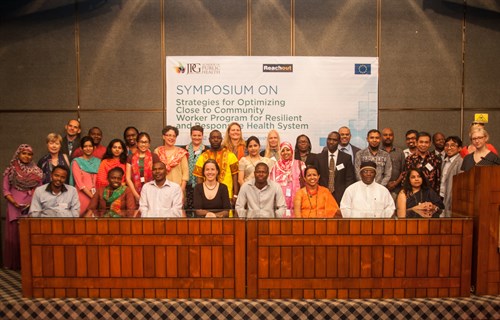
By Anushka Zafar
On 12 June 2016, REACHOUT team members from all six of its working countries came under one roof for a symposium on ‘Strategies for Optimizing Close To Community (CTC) Worker Programmes to Create more Resilient and Responsive Health Systems’. As part of a larger consortium of eight partners, the sixth consortium meeting was held in Bangladesh from 6-15 June, hosted by the REACHOUT Bangladesh team, at Brac University’s James P Grant School of Public Health (JPGSPH).
Panel presentations highlighted lessons learnt from CTC programmes in Bangladesh, Ethiopia, Indonesia, Kenya, Malawi and Mozambique. From each country, we see that CTC health providers stand at the intersection of several forces – such as the community, the health system and the market. They are not only deliverers of programmes, but often also health activists, engaging the community. They are also increasingly subjected to the forces the evolving health market, and must navigate this with very little guidance.
As a result, these health workers face a range of challenges. In Kenya, for instance, the programme is confronted with high dropout rates due to financial constraints. In Malawi, a lack of senior officers makes supervision of CTC workers more difficult. Meanwhile in Bangladesh, where CTC health workers mainly tend to hard-to-reach populations and rural villages, the programme now has to adapt to provide access to healthcare in urban slums, a dynamic space with pluralistic health services.
Overall, across each country, the findings show the need to provide support on both the supply and demand side; this includes retaining staff, sustaining CTC worker motivation, addressing lack of governance, and the overall sustainability of these programmes. There also needs to be greater investment in training and tools.
Looking at the obstacles and what the future holds for these programmes is particularly crucial as we go on to address more complex health targets. However there is a lot of scope to develop and assess interventions with the potential to make improvements to CTC services. Speakers from Malawi and Kenya discussed the opportunity to incorporate the use of mobile phones to strengthen and increase accuracy in data management. In Kenya, mobile applications for training CTC workers have also been established to reinforce their capacity development efforts. These are some examples of solutions to issues that seem to similarly challenge programmes in all six countries.
REACHOUT examines the big picture across each country and across time – this will not only reveal the larger story but also help each country learn from one another and implement improvements according to their context. Bringing REACHOUT team members together to examine the findings thus far continues to help generate informed, evidence-based and context-appropriate policies for future CTC services.
As we transition from Millennium Development Goals to the next set of Sustainable Development Goals, countries striving to achieve universal health coverage are increasingly depending on CTC health services. Now more than ever, there is a need for health systems to understand the context and conditions in which these services operate in order to realise their potential.
Anushka Zafar is a communications and knowledge manager at JPGSPH, Brac University
The photo should be credited to Istiak Tonu
Recent news
- How equitable are Community Health Worker programmes?, 31 May 2016
- How relationships shape community health workers’ performance in Ethiopia, Kenya, Malawi and Mozambique, 13 May 2016
- Co-constructing knowledge about health with the young people of Korogocho informal settlement, 28 April 2016

This project is funded by the European Union.
